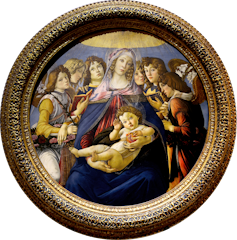Pomegranates are hot right now, the red fruit with its glistening jewel-like segments has become the center of a new TikTok trend. The hashtags #pomegranate and #pomegranategirl have been trending in videos featuring debates about sexuality and feminism.
At the risk of sounding all staid and academic but this all is just so Renaissance. Actually, it is more than that, as the roots of pomegranate symbolism and its links to femininity and sexuality extend into classical writings. You’ll find the connection in Herodotus’ Histories and in many religious texts – from those belonging to Christianity and Islam to Zoroastrianism.
In the Old Testament’s Song of Solomon, for example, the two cheeks of a blushing bride are compared to the two halves of a pomegranate. In Buddhist legend, meanwhile, the child-eating demoness Hariti is helped by Buddah to kick that evil habit by eating pomegranates and is often depicted with one.
TikTokers have, wittingly or not, joined this storied trend in creating videos that use the pomegranate as a symbol for exploring narratives around sexuality and especially fertility.
It is not difficult to see why the pomegranate has traditionally been considered a powerful visual metaphor for fertility. In most images of it, the fruit has been sliced open to reveal its vibrant red interior, with its rich pink pulp surrounding the plentiful seeds.
But many of the TikToks equate the opening of the pomegranates to narratives around sexual domination, male domination and violence and a brutal laying open of female vulnerability.
Historical depictions have rarely been so literal in engaging with these themes. There is some precedent in the artwork of the Renaissance. At this time pomegranates were an expression of male control of ideas around fertility and they promoted a limiting idealized femininity tied up in being a good wife and a highly fertile bearer of heirs.
The very model of a Renaissance wife
One Renaissance master who frequently depicted pomegranates in his renditions of the Virgin and Child was Sandro Botticelli (c. 1445-1510). Images of the Virgin and Child were an important staple for the Botticelli workshop. If a Renaissance workshop produced multiple versions of a theme, it meant that the idea was popular among art buyers of the time.

Wikimedia
These images of the Virgin and Child with pomegranates, often in round frames, tended to be hung in the private houses of their buyers. They were specifically displayed in homes as visual exemplars to inspire model behavior in Renaissance women living and bringing up their children within those spaces.
Reinforcing and inspiring model behavior was a key social concern for men of the Renaissance era. Such concern resulted in an abundance of treatises, tracts, letters and even sermons (here’s looking at you, Fra Bernardino da Siena) aimed at setting out model (female) behavior. One such example that circulated in elite circles not just in Italy but all over Europe was a treatise written by Francesco Barbaro in 1416.
Barbaro penned On Wifely Duties as a wedding gift for his friend Lorenzo de Medici, the most powerful and enthusiastic patron of Renaissance culture in Italy. In it, Barbaro sets out, in ten chapters, what the duties of the perfect Renaissance wife are and how this paragon of womanhood should behave. The key themes are love for her husband, modesty of life and diligent and complete care in domestic matters. Or, in other words, obedience, fertility and chastity in marriage.
These are of course the ideals celebrated in Botticelli’s Virgin and Child images with pomegranates. A beautiful but chaste and modest Virgin Mary holds her son close to her, in a safe and comfortable domestic environment. Both mother and child clutch the ubiquitous sliced open pomegranate, as a reminder to Renaissance women to emulate the domesticity and fertility of the Virgin Mary. In On Wifely Duties, Barbaro encourages young mothers to have such an image, a painting or a statue, in their home featuring a child with a bird or pomegranate in his hand.
A Tudor queen’s fertility issues

One Renaissance woman who was closely associated with pomegranates and issues surrounding fertility was Henry VIII’s first wife, Katherine of Aragon. Queen Katherine’s chosen badge included the pomegranate, together with the motto “humble and loyal”. This of course recalls Barbaro’s recommendations for the perfect wife.
Thomas More, Henry VIII’s lord high chancellor, wrote a series of poems on the occasion of their marriage. In these poems he did not hold back on what was expected of Katherine, including in this one called The Rose and The Pomegranate:
But your queen, fruitful in male offspring,
will render it on all sides stable and everlasting.
Great advantage is yours because of her, and similarly is
hers because of you.
There has been no other woman, surely, worthy
to have you as husband, nor any other man worthy to have
her as wife.
For Katherine, her pomegranate symbolism, with its expectations of fertility and adherence to social expectations of motherhood, became a curse. This is something the TikTok #pomegranategirl hashtag explicitly picks up and translates into contemporary debates about sexuality and gender norms.
However, if I can be a bit of a critic here, while their use on TikTok gets the message across, these posts are a bit repetitive. After the umpteenth viewing of yet another post of a sliced open pomegranate evoking a Georgia O’Keefe-esque vaginal aesthetic set to mournful music and poetry, I am a little bored.
Thousands of years of history of pomegranate symbolism and you get stuck in one groove? Come on Gen Z, raise your game and let’s see what you can make of the not-so-humble pomegranate.
Gabriele Neher, Associate Professor in History of Art, University of Nottingham.This article is republished from The Conversation under a Creative Commons license. Read the original article.









